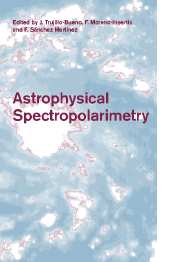Book contents
- Frontmatter
- Contents
- Participants
- Group Photograph
- Preface
- Foreword
- Acknowledgements
- The Physics of Polarization
- Polarized Radiation Diagnostics of Solar Magnetic Fields
- Polarized Radiation Diagnostics of Stellar Magnetic Fields
- Polarization Insights for Active Galactic Nuclei
- Compact Objects and Accretion Disks
- Astronomical Masers and their Polarization
- Interstellar magnetic fields and infrared-submillimeter spectropolarimetry
- Instrumentation for Astrophysical Spectropolarimetry
Interstellar magnetic fields and infrared-submillimeter spectropolarimetry
Published online by Cambridge University Press: 21 May 2010
- Frontmatter
- Contents
- Participants
- Group Photograph
- Preface
- Foreword
- Acknowledgements
- The Physics of Polarization
- Polarized Radiation Diagnostics of Solar Magnetic Fields
- Polarized Radiation Diagnostics of Stellar Magnetic Fields
- Polarization Insights for Active Galactic Nuclei
- Compact Objects and Accretion Disks
- Astronomical Masers and their Polarization
- Interstellar magnetic fields and infrared-submillimeter spectropolarimetry
- Instrumentation for Astrophysical Spectropolarimetry
Summary
The large-scale features of the magnetic field in the arms of the Galaxy have been traced by observations of polarized starlight, synchrotron emission, Zeeman splitting, and Faraday rotation. More recently, it has become possible to map fields in dense clouds by observations of polarized thermal emission from magnetically aligned dust grains. Observations at far-infrared and submillimeter wavelengths provide measurements of the field as projected on the sky at hundreds of points in individual clouds. In the polarization maps, especially when compared at several wavelengths, one finds examples of fields shaped by gravitational contraction, differential rotation, and compression. One also finds evidence for unresolved thermal structure and turbulence. To interpret the results one must understand the physical principles that relate emission, absorption, and scattering; and that relate polarization to the shapes and materials of the emitting dust grains. When these principles are applied to emission one finds that the degree of polarization in homogeneous clouds should be nearly independent of wavelength in the far-infrared and submillimeter portions of the spectrum. The steep polarization spectra actually observed can tentatively be understood if one assumes a heterogeneous temperature and radiation structure in which there is a correlation between temperature and grain alignment. The potential sources of systematic errors in polarization measurements are such that anyone entering the field must carefully review the appropriate observing and analysis techniques. With attention to the required techniques and with new instruments to be commissioned in the next few years it should become feasible to pursue scientific goals that have thus far been largely inaccessible.
- Type
- Chapter
- Information
- Astrophysical Spectropolarimetry , pp. 265 - 302Publisher: Cambridge University PressPrint publication year: 2001
- 1
- Cited by



